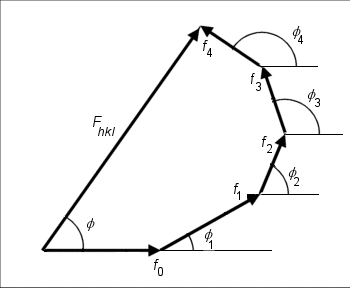Heavy-atom method
From Online Dictionary of Crystallography
Revision as of 09:41, 3 April 2008 by BrianMcMahon (talk | contribs)
An application of Patterson methods in crystal structure determination. For a compound containing a heavy atom (i.e. one with a significantly higher atomic scattering factor than the others present) the diffraction phases calculated from the position of the heavy atom are used to compute a first approximate electron density map. Further portions of the structure are recognisable as additional peaks in the map. Successive approximate electron density maps may then be calculated to solve the entire structure.
Discussion
The figure shows how the structure factor is derived by vector addition of the scattered waves from the different contributing atoms in the unit cell. Consider the case of an atom with a very much higher scattering factor than any of the others ([math]f_{0} \gt \gt \sum_{i} f_i[/math]); it is clear that the total phase angle [math]\phi[/math] will be small, and that the net phase of the structure factor differs very little from that of the heavy-atom component alone.
If the positions of known heavy atoms can be determined in this way, then the Patterson
